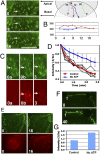Spontaneous assembly and active disassembly balance adherens junction homeostasis
- PMID: 20133579
- PMCID: PMC2840517
- DOI: 10.1073/pnas.0911027107
Spontaneous assembly and active disassembly balance adherens junction homeostasis
Abstract
The homeostasis of adherens junctions was studied using E-cadherin and its two mutants tagged by the photoconvertible protein Dendra2 in epithelial A-431 cells and in CHO cells lacking endogenous cadherin. The first mutant contained point mutations of two elements, Lys738 and the dileucine motif that suppressed cadherin endocytosis. The second mutant contained, in addition, an extensive truncation that uncoupled the mutant from beta-catenin and p120. Surprisingly, the intact cadherin and its truncated mutant were recruited into the junctions with identical kinetics. The full-size cadherin was actively removed from the junctions by a process that was unaffected by the inactivation of its endocytic elements. The cadherin's apparent half-residence time in the junction was about 2 min. Cadherin clusters made of the truncated mutant exhibited much slower but ATP-independent junctional turnover. Taken together, our experiments showed that adherens junction homeostasis consists of three distinctive steps: cadherin spontaneous recruitment, its lateral catenin-dependent association, and its active release from the resulting clusters. The latter process, whose mechanism is not clear, may play an important role in various kinds of normal and abnormal morphogenesis.
Conflict of interest statement
The authors declare no conflict of interest.
Figures




Similar articles
-
RAC1 regulates adherens junctions through endocytosis of E-cadherin.Mol Biol Cell. 2001 Apr;12(4):847-62. doi: 10.1091/mbc.12.4.847. Mol Biol Cell. 2001. PMID: 11294891 Free PMC article.
-
Cadherin tales: Regulation of cadherin function by endocytic membrane trafficking.Traffic. 2016 Dec;17(12):1262-1271. doi: 10.1111/tra.12448. Epub 2016 Oct 27. Traffic. 2016. PMID: 27624909 Review.
-
Cadherin controls nectin recruitment into adherens junctions by remodeling the actin cytoskeleton.J Cell Sci. 2015 Jan 1;128(1):140-9. doi: 10.1242/jcs.161588. Epub 2014 Nov 13. J Cell Sci. 2015. PMID: 25395582 Free PMC article.
-
Endocytosis of cadherin from intracellular junctions is the driving force for cadherin adhesive dimer disassembly.Mol Biol Cell. 2006 Aug;17(8):3484-93. doi: 10.1091/mbc.e06-03-0190. Epub 2006 Jun 7. Mol Biol Cell. 2006. PMID: 16760429 Free PMC article.
-
Adherens junction turnover: regulating adhesion through cadherin endocytosis, degradation, and recycling.Subcell Biochem. 2012;60:197-222. doi: 10.1007/978-94-007-4186-7_9. Subcell Biochem. 2012. PMID: 22674073 Free PMC article. Review.
Cited by
-
Cadherin exits the junction by switching its adhesive bond.J Cell Biol. 2011 Mar 21;192(6):1073-83. doi: 10.1083/jcb.201006113. J Cell Biol. 2011. PMID: 21422232 Free PMC article.
-
Lateral adherens junctions mediate a supracellular actomyosin cortex in drosophila trachea.iScience. 2023 Mar 13;26(4):106380. doi: 10.1016/j.isci.2023.106380. eCollection 2023 Apr 21. iScience. 2023. PMID: 37009223 Free PMC article.
-
Quantifying cadherin mechanotransduction machinery assembly/disassembly dynamics using fluorescence covariance analysis.Sci Rep. 2016 Jun 30;6:28822. doi: 10.1038/srep28822. Sci Rep. 2016. PMID: 27357130 Free PMC article.
-
MARCH family E3 ubiquitin ligases selectively target and degrade cadherin family proteins.PLoS One. 2024 May 9;19(5):e0290485. doi: 10.1371/journal.pone.0290485. eCollection 2024. PLoS One. 2024. PMID: 38722959 Free PMC article.
-
There are four dynamically and functionally distinct populations of E-cadherin in cell junctions.Biol Open. 2015 Oct 15;4(11):1481-9. doi: 10.1242/bio.014159. Biol Open. 2015. PMID: 26471767 Free PMC article.
References
-
- Yap AS, Brieher WM, Gumbiner BM. Molecular and functional analysis of cadherin-based adherens junctions. Annu Rev Cell Dev Biol. 1997;13:119–146. - PubMed
-
- Takeichi M. Morphogenetic roles of classic cadherins. Curr Opin Cell Biol. 1995;7:619–627. - PubMed
-
- Troyanovsky S. Cadherin dimers in cell-cell adhesion. Eur J Cell Biol. 2005;84:225–233. - PubMed
-
- Provost E, Rimm DL. Controversies at the cytoplasmic face of the cadherin-based adhesion complex. Curr Opin Cell Biol. 1999;11:567–572. - PubMed
Publication types
MeSH terms
Substances
Grants and funding
LinkOut - more resources
Full Text Sources
Other Literature Sources

